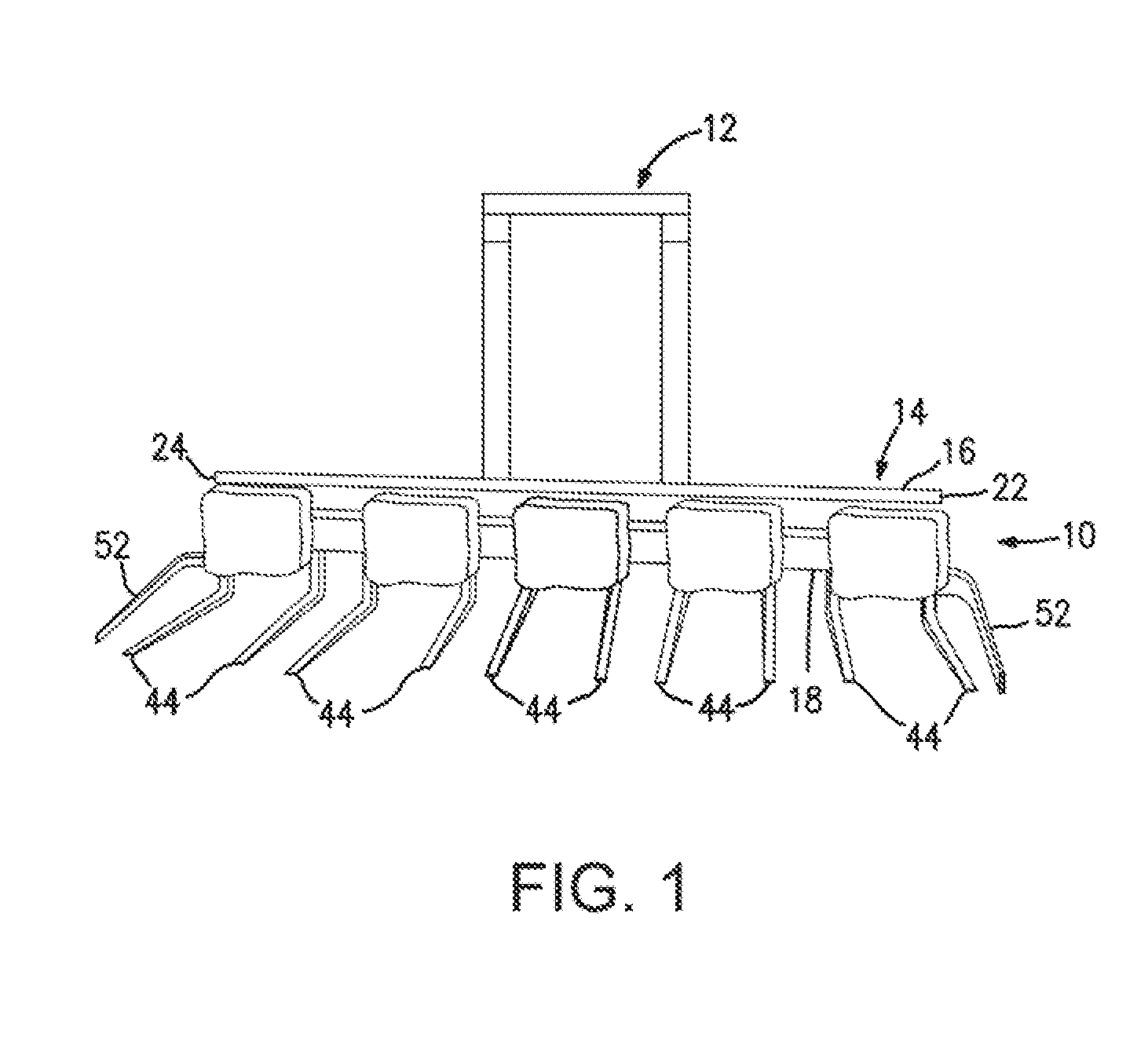Pickup and alignment mechanism for logs and a method of use
- Summary
- Abstract
- Description
- Claims
- Application Information
AI Technical Summary
Benefits of technology
Problems solved by technology
Method used
Image
Examples
second embodiment
[0077]Referring now to FIGS. 7-11, a pickup and alignment mechanism for logs 10′ is shown. In this embodiment, like numerals refer to similar elements as were shown in FIGS. 1-6. This pickup and alignment mechanism 10′ differs from the previously disclosed pickup and alignment mechanism 10 in that it includes a first chain saw 64, a second chain saw 66, and a third chain saw 68. In addition, the pickup and alignment mechanism 10′ uses eight L-shaped tines 44, 44 instead of ten, and therefore needs only four bumpers 58, 58. Each of the first, second and third chain saws, 64, 66 and 68 respectively, can be a typical chain saw having a chain saw blade 70 that can vary in length. Each chain saw blade 70 should be at least 36 inches in length. More desirably, each chain saw blade 70 should be at least 48 inches in length. Even more desirably, each chain saw blade 70 should be at least 60 inches in length. Most desirably, each chain saw blade 70 is greater than 60 inches. All three chain ...
third embodiment
[0093]Referring now to FIGS. 13-17, a pickup and alignment mechanism for logs 10″ is shown. In this embodiment, like numerals refer to similar elements as were shown in FIGS. 1-6. The pickup and alignment mechanism 10″differs from the second previously disclosed pickup and alignment mechanism 10′ in that it includes ten L-shaped tines 44, 44, similar to what is shown in FIGS. 1-6. In addition, the pickup and alignment mechanism 10″utilizes four chain saws and a single grappling member. The four chain saws include a first chain saw 64, a second chain saw 66, a third chain saw 68 and a fourth chain saw 69. The third and fourth chain saws, 68 and 69 respectively, are positioned between the first and second chain saws, 64 and 66 respectively. Each of the four chain saws 64, 66, 68 and 69 has a chain saw blade 70. The four chain saws 64, 66, 68 and 69 should be operated sequentially to prevent one of the chain saw blades 70 from becoming wedged or pinched as a cut is being made. Desirabl...
fourth embodiment
[0099]Referring now to FIG. 18, a pickup and attachment mechanism for logs 10′″ is shown. The pickup and attachment mechanism 10′″ is similar to that shown in FIGS. 7-11 except for a few differences. First, each of the four pairs of L-shaped tines 44, 44 is replaced by a single tine 44, each having a flat plate 88 secured thereto. Only four L-shaped tines 44, 44, 44 and 44 are needed in this embodiment instead of eight L-shaped tines 44. Each of the four plates 88 can vary in size, thickness and configuration. As depicted, each of the four plates 88, 88, 88 and 88 has a generally rectangular shape. Each of the four plates 88, 88, 88 and 88 can be welded onto an upper surface of each of the four L-shaped tines 44, 44, 44 and 44. Each of the four plates 88, 88, 88 and 88 has a width w2 which is approximately equal to the width w1 of each of the four bumpers 58, 58, 58 and 58. Desirably, the width w2 of each plate 88 is equal to the width w1 of each bumper 58.
[0100]Another difference o...
PUM
| Property | Measurement | Unit |
|---|---|---|
| Fraction | aaaaa | aaaaa |
| Thickness | aaaaa | aaaaa |
| Thickness | aaaaa | aaaaa |
Abstract
Description
Claims
Application Information
 Login to View More
Login to View More - R&D
- Intellectual Property
- Life Sciences
- Materials
- Tech Scout
- Unparalleled Data Quality
- Higher Quality Content
- 60% Fewer Hallucinations
Browse by: Latest US Patents, China's latest patents, Technical Efficacy Thesaurus, Application Domain, Technology Topic, Popular Technical Reports.
© 2025 PatSnap. All rights reserved.Legal|Privacy policy|Modern Slavery Act Transparency Statement|Sitemap|About US| Contact US: help@patsnap.com



